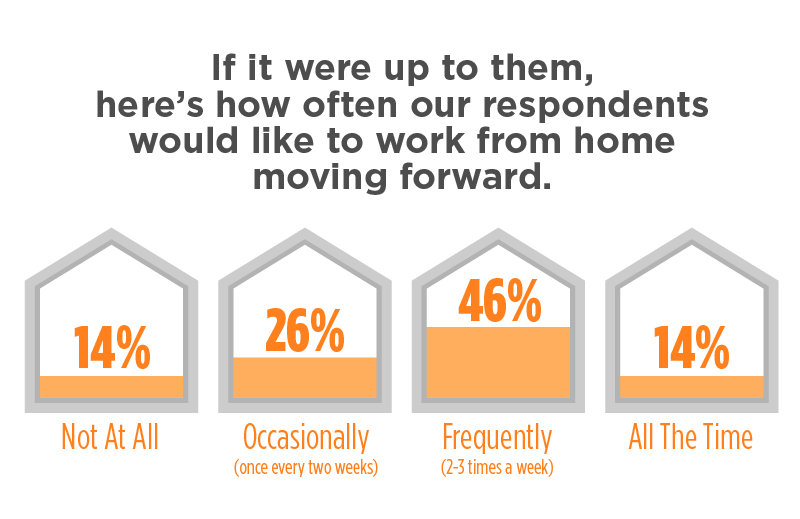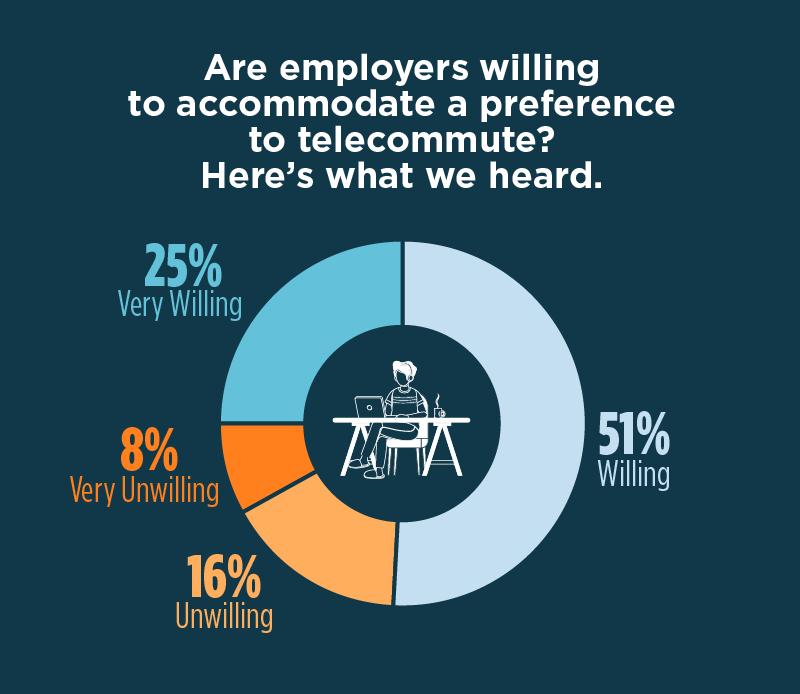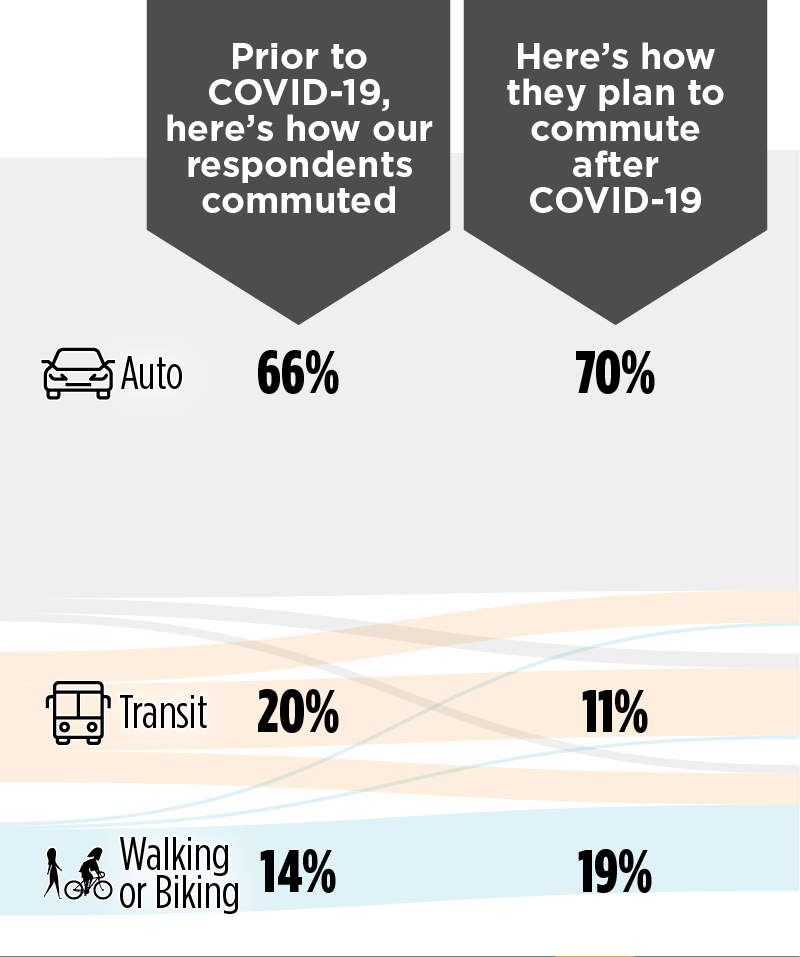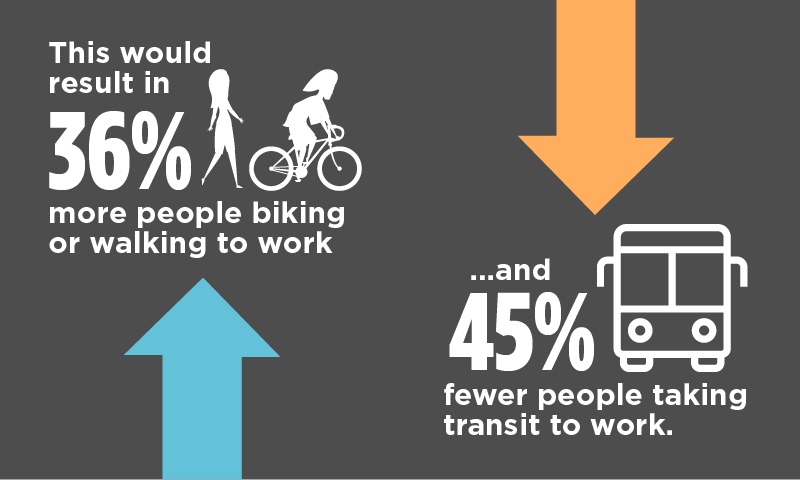July 21, 2020
COVID-19 has undoubtedly changed many work situations in the present. Will any of these changes stick around to be part of the “new normal” after the pandemic?
As the transportation engineering and planning profession looks to the future, many of us are asking if COVID-19 will permanently change employees’ attitudes toward working from home and/or the modes of transportation they take to work. Here are the results of an informal survey we coordinated to get an early idea of how commuting and teleworking patterns may change long-term in light of COVID-19.










![]() In the healthcare industry, a larger percentage indicated that teleworking is not an option, and 43% indicated their employers are either unwilling or very unwilling to accommodate teleworking.
In the healthcare industry, a larger percentage indicated that teleworking is not an option, and 43% indicated their employers are either unwilling or very unwilling to accommodate teleworking.
![]() Respondents who selected “government” as their industry were overwhelmingly in favor of teleworking, with 81 out of 84 indicating they’d like to work from home occasionally, frequently, or full-time.
Respondents who selected “government” as their industry were overwhelmingly in favor of teleworking, with 81 out of 84 indicating they’d like to work from home occasionally, frequently, or full-time.
![]() Responses from education professionals also weighted heavily toward teleworking, with 71 out of 90 respondents indicating they’d like to work from home occasionally, frequently, or full-time.
Responses from education professionals also weighted heavily toward teleworking, with 71 out of 90 respondents indicating they’d like to work from home occasionally, frequently, or full-time.
![]() Respondents in architecture/engineering/planning professions indicated the highest likelihood of employer willingness, with 86% of respondents indicating their employers would be either willing or very willing to support telecommuting. Less than 2% marked “very unwilling”.
Respondents in architecture/engineering/planning professions indicated the highest likelihood of employer willingness, with 86% of respondents indicating their employers would be either willing or very willing to support telecommuting. Less than 2% marked “very unwilling”.
 While this was an informal survey and 1,000 is a small sample size compared to the more than 150 million Americans who commute or telework every day, stated preference surveys like this one can help shine a light into what shifts we may see in teleworking and commute patterns in the future – and what we learned from respondents matches the commute patterns we’re already seeing as states move further into reopening.
While this was an informal survey and 1,000 is a small sample size compared to the more than 150 million Americans who commute or telework every day, stated preference surveys like this one can help shine a light into what shifts we may see in teleworking and commute patterns in the future – and what we learned from respondents matches the commute patterns we’re already seeing as states move further into reopening.
What might COVID-19 mean for”¦ traffic volumes?
Commute trips make up only about one fifth of all trips in a given day. So while our survey suggests that there may be reductions in commute trips, the impact to total daily trips is likely to be small. This is because of the combined effects of other factors that might offset the telecommuting findings, including for example a possible decrease in average car occupancy and/or the emergence of latent demand. Even so, the results to date of this ongoing survey make clear that significant changes probably will occur in such areas as (a) the trip generation rates associated with certain land uses; (b) the distribution of trip purposes and travel patterns; and (c) the time-of-day distribution profile of traffic volumes.
What might COVID-19 mean for”¦ public transit ridership?
About half of respondents who told us that they used to commute by public transport indicated that they are looking to change modes post-pandemic (note that our survey sample skews heavily toward commuters who have access to a car). We think that transit agencies will have to work even harder to attract riders by providing personal protective equipment, improving sanitation, reducing crowding, and ventilating vehicles. Unfortunately, declines in ridership and in funding sources combined with rising costs may cause transit agencies to reduce service frequency and/or eliminate some routes, meaning that individuals who rely on transit for their transportation needs will experience a decrease in mobility and/or an increase in transportation costs.
What might COVID-19 mean for”¦ bike commuting?
The survey results indicate that the percentage of home-based work trips made by biking will increase – matching the intense interest in bicycling for recreational and utilitarian purposes over recent months. Even if this reflects the acceleration of a trend that was already underway, it may behoove local communities to consider a similar acceleration of plans to provide more continuity of their bicycle routes, pay more attention to the safety and comfort of people biking to work, and devote budget for higher levels of attention to the maintenance and operation of bicycle facilities
What might COVID-19 mean for”¦ your office capacity?
We expect that companies where telecommuting is encouraged will right-size their space requirements to match the number of staff that will be at the office on a typical day.
As an example, an analysis of responses by those in the engineering/planning profession who noted their employers were willing or very willing to accommodate telecommuting suggests that a third of trips into the office will be replaced by telecommuting. If these trips to the office are staggered, an employer may be able to reduce its footprint by a third and still provide a similar amount of space per employee physically present.
Incubator spaces might also see a decrease in demand for space as individuals opt to work from home. These changes probably won’t occur immediately but are likely to play out over the next two to five years, which is the time period within which most existing office leases will need to be renewed.
Reach Out
While no one has all the answers today – and we recognize our survey is not representative of all commuters in the United States – these questions have tremendous implications for the future of the transportation profession and how we can be planning. To see more of our detailed findings, including breakdowns by location, or to talk about the application of research studies like this one, reach out to Wayne Kittelson and Jorge Barrios!
You can download our full dataset of questions and responses, except personally identifiable information, by clicking on this link. If you use this data publicly, please attribute it to “Kittelson & Associates, Inc.”
